Introduction
When a hunter takes on dangerous game the element of risk is heightened. Dangerous animals are often much heavier, faster and more agile than the human species. For the most part you cannot take them on and survive unless you have a powerful rifle in your hands. They can maul, squash or pound you to death with body mass, trunk, tooth, tusk, horn or claw and if you do not have a powerful “bangstick” in your hands and the ability to shoot straight you will die or be very seriously injured. Even with a rifle of adequate calibre the risk is still real and it’s this awareness of one’s own mortality that adds the spice and excitement to hunting Africa’s dangerous big game.
Calibre description and specifications
The.500 Nitro Express 3” is a .510 calibre, rimmed, tapered case cartridge designed by Westley Richards in 1890 to be used in single shot and double rifles. The rimmed case is tapered to facilitate easy feeding in double rifles. The cartridge specs are shown in Figure 1.
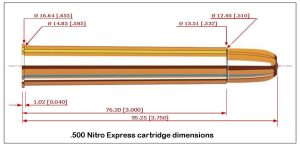
The .500 calibre group of rifles date back to the era of black powder cartridges and have a reliable reputation that has lasted nigh on 125 years. The .500 Nitro Express 3”, used more in India on tigers, leopards, and elephants than in Africa, did also however prove its worth in the hands of African hunters.
Driving a heavy 570-grain projectile at 2150 fps the .500 Nitro Express superseded its .450NE, .500/.465, and .470 NE in performance.
The large capacity of the .500 Express case is due to the cartridge originally being designed to use black powder as a propellant. The 3.00 in (76 mm) case has a case capacity of 138 grains of H2O.
History
The .500 Nitro Express has a lineage that dates back to its black powder ancestor, the .500 Black Powder Express, which first appeared on the scene in the 1860s. The .500 Black Powder Express fired a 440-grain bullet at a respectable 1500fps producing 2198 ft. lbs of energy. With Alfred Nobel’s invention of smokeless propellants, the British created their own version called Cordite in 1889, and it didn’t take them long to create the next version of the .500, the .500 Nitro for Black Powder, in the 1890s. The intention of the .500 Nitro for Black Powder was that it operated at the low pressures necessary to allow its safe use in the existing black powder rifles. Using Cordite it was not only possible to do this but also to improve on the performance of the .500 Black Powder Express. The .500 Nitro for Black Powder drove a 440 grain bullet at 1,900fps producing 3,258 ft. lbs of energy. Both these cartridges were more than adequate for small and medium-sized species but were not intended for use on dangerous big game animals. The black powder 8 bore, and in rarer instances the 4 bore were the cartridges of choice when hunting elephants at that time.
The potential for the large and gently tapered case of the .500 as a pure-bred nitro cartridge for dangerous game was recognized in the 1890’s and the new .500 Nitro Express made its debut running at nitro propellant pressures and driving a 570-grain jacketed bullet at 2,150fps producing 5,850 ft. lbs of energy. This cartridge quickly proved itself in the hunting fields of Asia and Africa. The cartridge was used in much lighter rifles which had the ability to drive bullets home into the vitals of thick-skinned dangerous game. Why carry around a heavy 8 or 4 bore and have your shoulders destroyed by their massive recoil when a lighter rifle producing superior ballistics could do the job better!
Nitro propellants gave rise to a number of dangerous game cartridges from the late 1890s and the years preceding the First World War. This created a lot of competition for the .500 Nitro Express. The .450-.470 caliber cartridges became increasingly popular and two heavy stopping nitro calibers appeared, the .577 Nitro Express and the .600 Nitro Express.
It was the “done thing” of that day for a hunter to have two rifles – a lighter “carry rifle” in one of the .450-.470 nitro calibers, and a heavy “stopper” which, in most cases, was a .577 or 600 Nitro Express. This led to the .500 Nitro becoming less popular which in no way should be seen as a reflection of poor or inadequate performance. On the contrary, it was a superb cartridge.
A two-gun hunter would carry the lighter rifle himself whereas the heavy “stopping double rifle” in .577 or .600 Nitro Express would be carried by a gun-bearer (Figure 2).
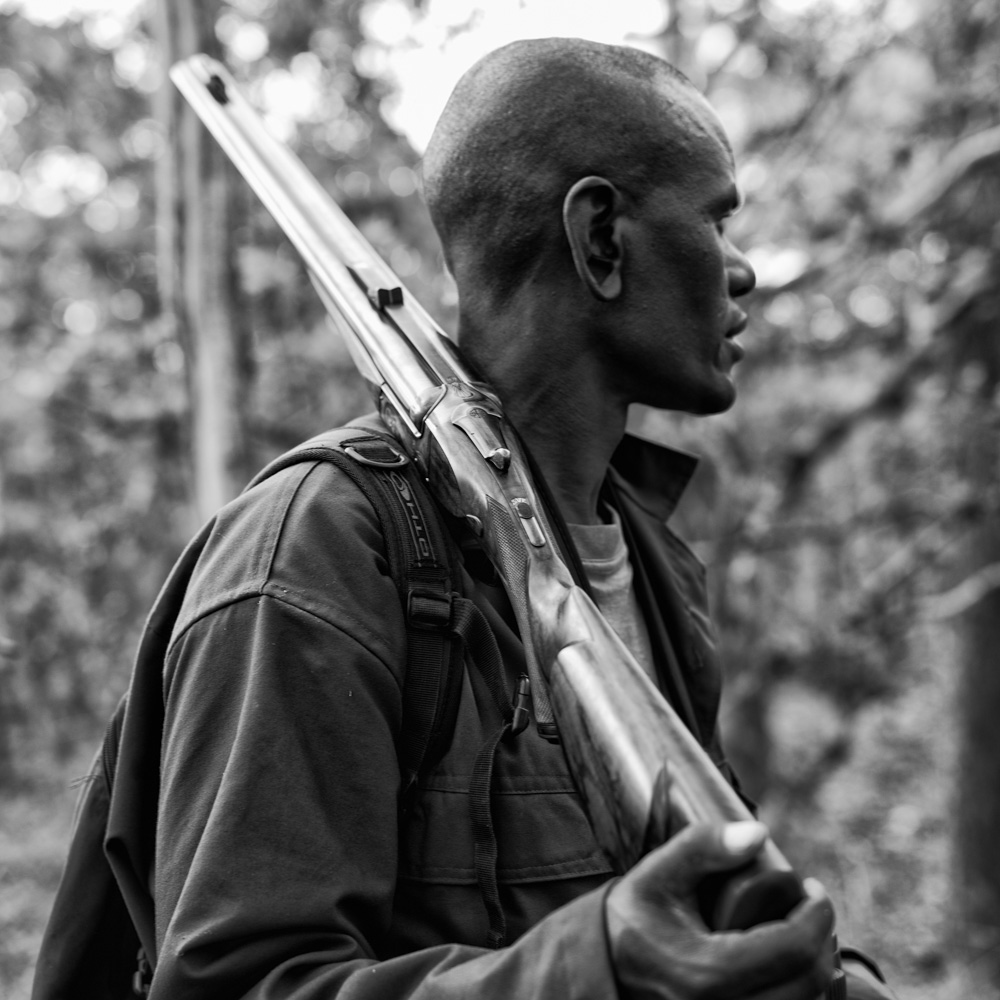
The problem with having two rifles was that in an emergency the hunter may not have been able to retrieve his big “stopper” from the gun bearer in time (or the frightened gun bearer ran off with it!). If a hunter used two rifles he would also have to practice and become proficient with both. With the aid of modern chronographs and testing equipment, it can now be shown that the .500 NE 3”, using standard factory-loaded FMJ bullets has better penetration than either the 577 or .600 Nitro Express.
With the wisdom of hindsight, hunting with a single rifle (.500 NE) would have been a better option than hunting with two and it would have performed just as well if not better than the “heavy stopper”.
To get an idea of the recoil of the .500 Nitro Express 3”, which can be imposing to those who are recoil shy, see Table 1 which compares the Relative Recoil Factor (RRF) to other well-known calibres. Recoil using factory ammunition typically produces 85 ft. lbs. of recoil energy using a 10 lb. (4.5 kg.) rifle.
CALIBRE | RELATIVE RECOIL FACTOR |
.270 Winchester | 1.82 |
.308 Winchester | 1.95 |
.375 H&H Magnum | 3.42 |
.416 Rigby | 4.27 |
.458 Winchester Magnum | 4.36 |
.500 Nitro Express 3-inch | 5.52 |
.700 Nitro Express | 9.00 |
Table 1: Relative Recoil Factors
Ballistics
The .500 NE 3” was designed with the largest game in mind and it admirably fulfilled its intended role. Bullets of .510 diameter and sectional density of the order of 0.313 made for excellent penetration at close range and shots inside 75 yards (more or less maximum for this cartridge).
Typical ballistics for the .500 Nitro Express is shown in Table 2 below.
Cartridge | Bullet | Muzzle Velocity | Muzzle Energy | Comments |
.500 Black Powder Express | 440-grain | 1,500 fps. | 2,198 ft.lb | Original black-powder load. Similar to the Sharps Winchester |
.500 Nitro for Black Powder | 440-grain | 1,900 fps. | 3,528 ft.lb | Kynoch nitro load for BP rifles. |
.500 Nitro Express 3” | 570-grain FMJ/SP | 2,150 fps. | 5,850 ft.lb | Kynoch NE load |
Table 2: A comparison of .500 Express Cartridge ballistics. The .500 NE 3” is shown on the bottom.
It is a great “stopper” with 5850 ft. lbs. of muzzle energy. A well-made rifle of this calibre weighs in at about 12 pounds and is comfortable to carry as opposed to double rifles chambered for .577 NE, .600 NE, and the daunting .700 NE which can weigh around 17-18 pounds.
Recommended For Species
This is a calibre intended for dangerous thick-skinned big game such as buffalo, elephant, hippo, and rhino but can of course also be used on big cats. The 570-grain solid bullet is used mainly for elephants but is also used in some situations for Cape buffalo and rhinoceros when the extra penetration provided by these non-expanding bullets is desired. Mated with the 570-grain solid bullet, the .500 Nitro Express has become the quintessential elephant cartridge on the African savanna. The round-nose soft point 570-grain bullet can be used on most other game species.
Manufacturers of .500 NE 3” Cartridges
During the heyday of hunting every major manufacturer of British dangerous game rifles produced ammunition for the .500 Nitro Express rifles. By the 1960’s however only Kynoch was left still producing ammunition in this calibre and owing to lack of interest Kynoch ended production of the Nitro Express cartridges in 1970.
A revival in the popularity of African hunting safaris from the 1990s onward led to renewed interest in this cartridge and whereas previously American ammunition manufacturers expressed little interest in British big bore ammunition, demand created by American hunters encouraged companies such as A-Square, Federal, and Hornady to begin producing ammunition for this calibre. Eley, which had purchased Kynoch, licensed the brand name to Kynamco in Suffolk in the United Kingdom and also began producing British sporting cartridges including the Nitro Express cartridge for sale using the Kynoch brand name. Norma of Sweden also offers this cartridge for sale.
Norma loads a great pair of bullets for the .500 Nitro Express 3”: the Woodleigh Weldcore softpoint and the Woodleigh Full Metal Jacket, both at 570 grains. While rhino hunting has all but come to an end, the Full Metal Jacket load is absolutely perfect for elephant hunting, and the excellent Weldcore softpoint will handle all other species of game. Because brass cases can tarnish quickly in the muggy heat of Africa, Norma offers their cartridges in plated nickel.
Federal Premium Cape-Shok Ammunition is a great choice for any safari. Federal’s Cape-Shok ammunition, as with Norma, is loaded into nickel-plated brass cases to resist corrosion and to facilitate smooth and reliable feeding. Each primer is lacquer-sealed to protect against moisture and assure instant ignition. A variety of loadings and bullets are available to cover the spectrum of plains and dangerous game.
Ballistics of some currently available cartridges for the .500 Nitro Express 3” are shown in Table 3 below and examples are in Figure 3. Be ready to fork out your hard-earned money for this ammunition – it is expensive.
VELOCITY fps. | ENERGY ft. lbs. | BULLET DROP inches | ||||||
BULLET | Muzzle | 100 yards | 200 yards | Muzzle | 100 yards | 200 yards | 100 yards | 200 yards |
Norma 570gr Woodleigh Weldcore SN | 2100 | 1903 | 1719 | 5583 | 4585 | 3742 | 0.0 | -8.0 |
Norma 570gr Woodleigh FMJ | 2100 | 1893 | 1701 | 5583 | 4538 | 3664 | 0.o | -8.1 |
Hornady 570gr DGX Bonded | 2150 | 1881 | 1635 | 5850 | 4477 | 3384 | 0.0 | -9.0 |
Hornady 570gr DGS Bonded | 2150 | 1881 | 1635 | 5850 | 4477 | 3384 | 0.0 | -9.0 |
Federal 570gr Woodleigh Hydro Solid | 2100 | 1809 | 1550 | 5581 | 4143 | 3041 | 0.0 | -9.3 |
Federal 570gr Swift A-Frame | 2100 | 1851 | 1625 | 5581 | 4336 | 3342 | 0.0 | -8.8 |
Kynoch 570gr SN | 2150 | 1948 | – | 5850 | 4800 | – | – | – |
Kynoch 570gr S | 2150 | 1948 | – | 5850 | 4800 | – | – | – |
Typical barrel used for testing: 26-inch barrel – 1 turn in a 16.5-inch twist. Rifles sighted in at 100 yards
Table 5: Ballistics of some commercial cartridges currently available for the .500 Nitro Express 3

Famous hunters who used this calibre
The proof of the pudding of any African dangerous game rifle calibre is to see who has used it successfully on African big game or who still uses it. Who better to look at as examples than some of the great African hunters and rangers. John A. Hunter, well-known Kenyan PH, killed more rhinos than anyone ever will again, and his favourite calibre was – you guessed it – the .500 Nitro Express 3”.
Tanzanian PH Peter Dafner uses this calibre and it is also the favorite big game rifle of Geoff McDonald, the founder of Woodleigh Bullets. He has taken many buffalo, elephant, and other game over a 30-year period with it (see Figure 4).

Manufacturers of .500 Nitro Express rifles
Westley Richards, Heym, Merkel, Rigby, and Krieghoff manufacture double rifles for this cartridge (Figures 5 and 6). The workmanship on all these rifles is superlative (Figures 7 and 8) and you will pay through your ears for one starting at around R190 000 up to R2 million!

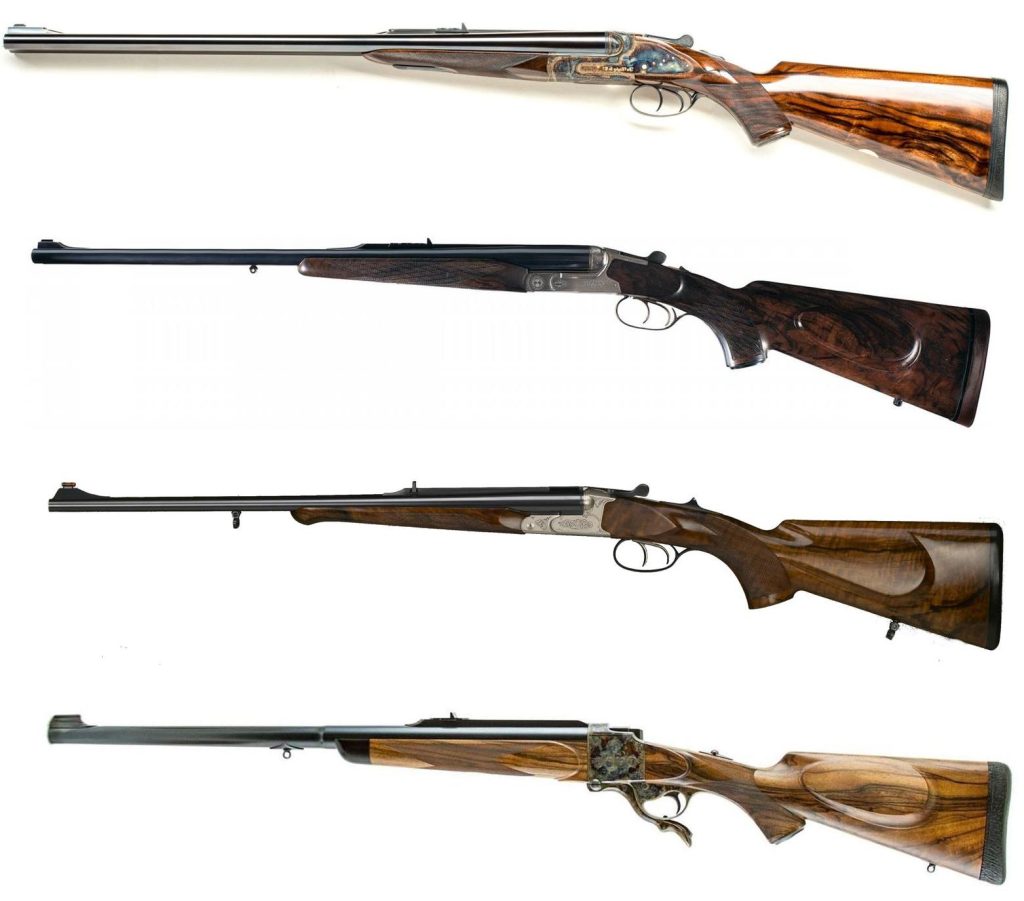
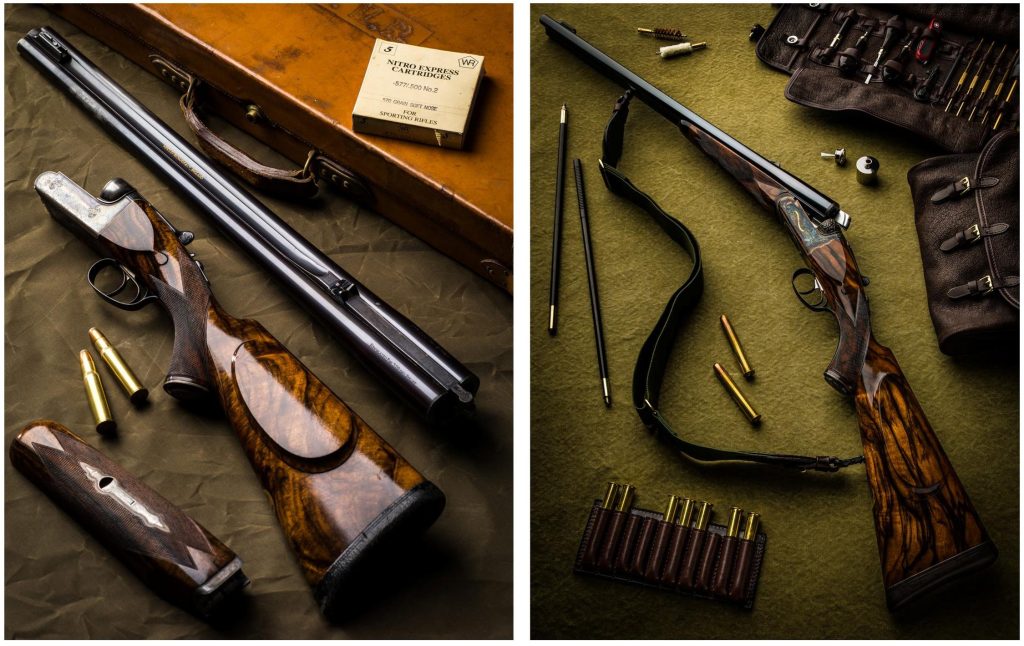
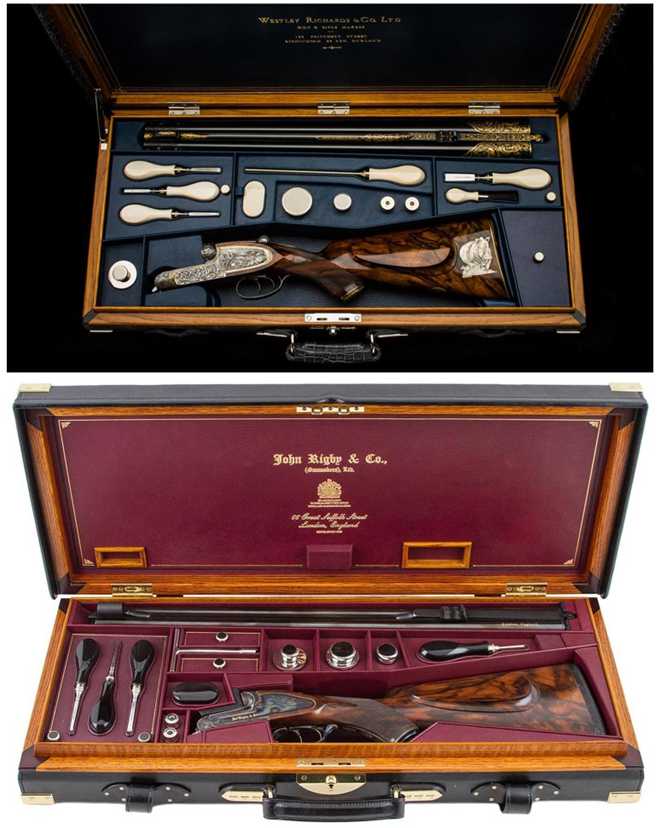
HANDLOADING THE .500 NITRO EXPRESS
Hornady and Norma sell cases for this calibre. See Table 4 below for some reloading data. As a rough equivalent H4831 is very close in burning rate to Somchem S385, IMR 4350 to S365. This can give you a ballpark figure of where to begin using South African powder but we can assume no responsibility for your reloading – that you must assume responsibility for. Bullets for this calibre are available from Woodleigh, Barnes, Hornady, and locally from Stewart (see Figure 9).
MAKE | POWDER | PRIMER | BULLET
| CASE | START/MAX LOAD gr | VELOCITY fps |
Hodgdon | H4350 | Federal 215M Large Rifle Magnum | 570 gr Hornady DGX | Hornady | 98.8/106.3 | 2001/2188 |
H4831 | Federal 215M Large Rifle Magnum | 570 gr Hornady DGX | Hornady | 106.0/114.0 | 1989/2145 | |
IMR | IMR4350 | Federal 215M Large Rifle Magnum | 570 gr Hornady DGX | Hornady | 97.3/104.7 | 1960/2075 |
IMR4320 | Federal 215M Large Rifle Magnum | 570 gr Barnes banded solid | A-Square | 86.5/91.5 | 1979/2120 | |
IMR4451 | Federal 215M Large Rifle Magnum | 570 gr Hornady DGX | Hornady | 98.5/106.0 | 1941/2100 | |
IMR4831 | Federal 215M Large Rifle Magnum | 570 gr Hornady DGX | Hornady | 106.0/114.0 | 1971/2137 | |
IMR4955 | Federal 215M Large Rifle Magnum | 570 gr Hornady DGX | Hornady | 108.0/115.0 | 1975/2107 | |
IMR7828 | Federal 215M Large Rifle Magnum | 570 gr Hornady DGX | Hornady | 108.1/115.0 | 1902/2041 |
Table 4: Handloading data using a variety of propellants (you take responsibility for your own reloading)
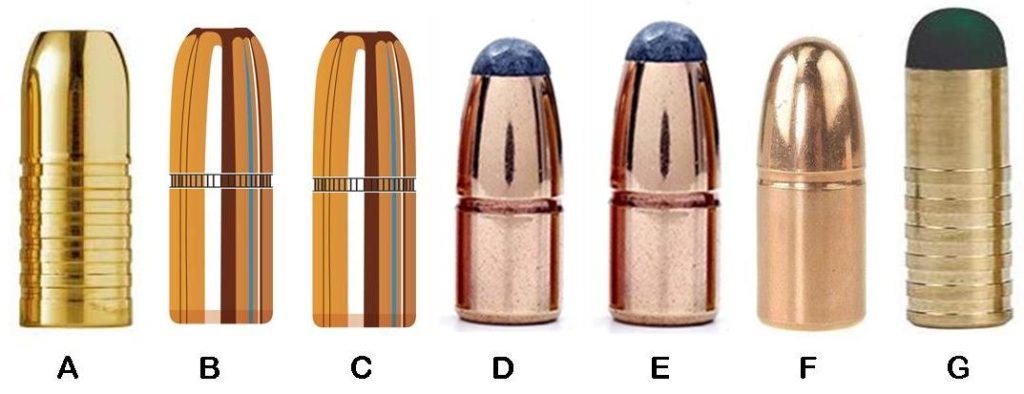
The present and the future
Historically, the potential of the .500 Nitro Express was overshadowed by the more popular and lighter-recoiling .450 and .470, and the hugely powerful .577 and .600NE. However, many of the .450-class cartridges, like the .475NE, the .500/465, the .476 NE, and others, have now faded into obscurity, whilst the .500 NE is not only hanging on but as its potential is realized is seeing a revival.
If you are looking for a stopping double-rifle cartridge, one with a track record that stretches back to the nineteenth century, then the .500 Nitro Express may be for you. It is a superb, hard-hitting, and reliable cartridge that will not disappoint you or fail you when the chips are down. It has been a favored calibre of choice amongst both professional hunters and sportsmen for well over a century.
References
Bussard, M. (2011): Ammo Encyclopedia 3rd Ed. Ingrid Book Company and Baker and Taylor.
Forker, B. (2006): Ammo & Ballistics 3rd Ed. Safari Press.
Sanchez-Arino, T. (2013): Great African Calibers. Safari Press.
Somchem (2012): Reloading Powders. Ballistic Data Manual.
https://en.wikipedia.org/wiki/.500_Nitro_Express
https://www.barnesbullets.com/files/2015/03/500NitroExpress.pdf
http://www.t2ammo.com/data/_uploaded/file/Techniek/Powder%20Burn%20Rate%20Chart.pdf

